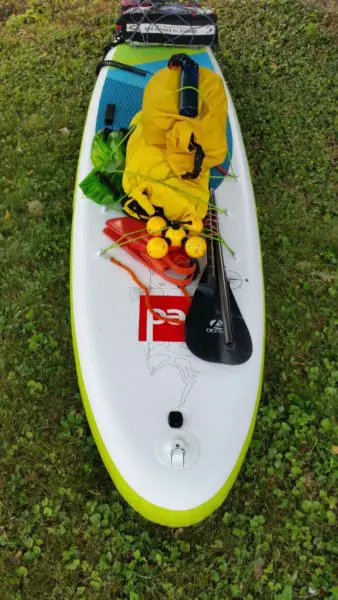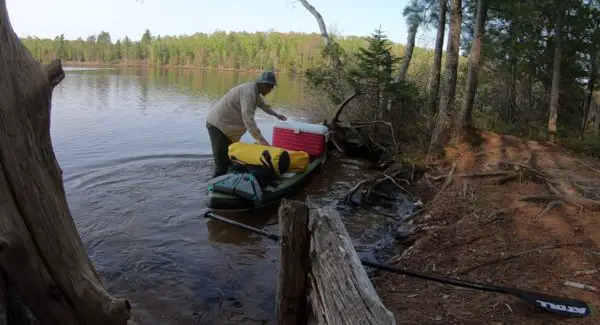
Packing Gear on a Paddle Board for Overnight SUP Camping
Part of planning a sup camping or fishing trip is determining:
- what gear you will take
- how you will organize it
- where it will go on your paddle board
How you pack your gear on your paddle board really comes down to personal choice. Through trial and error I have found the method that works best for me.
The important points are to keep your gear organized and also distributed properly on your paddle board so it feels completely stable and paddles naturally.
How to organize your gear
Many
small bags
inside
one large main bag
is the
ideal setup
The best way to organize your sup camping gear is to break your gear down into categories. Then have small stuff sacks or dry bags for each category. Take those small bags and put them in one (or two) large main dry bags.
If your trip has a long portage you may want to cut back on gear so you can fit everything into one or two 55-60 Liter backpack-style dry bags. I have never found a backpack-style dry bag larger than 60 Liters but I have seen 70-90 Liter duffel-style dry bags.
Dry Bag Gear Categories
- Sleeping System
- Clothing
- Kitchen
- Food
- Miscellaneous
- Safety/ Emergency
- Personal Items
- GoPro/Camera/Electronic Equipment
- Wet Clothing
- Fishing Equipment
- Easy Access – Often Used Items
This may seem like a lot of categories. But this system works well in keeping all your gear organized and easy to find.
Of course, you can combine certain categories. Sleeping system and clothing, Kitchen and food, Misc.,safety and personal all combine well.
You can label each bag with a duct tape label or just use different colors, brands and sizes of dry bags.
Within these small category bags I will use zip lock freezer bags to organize even further. These clear bags keep small items organized and easy to find.
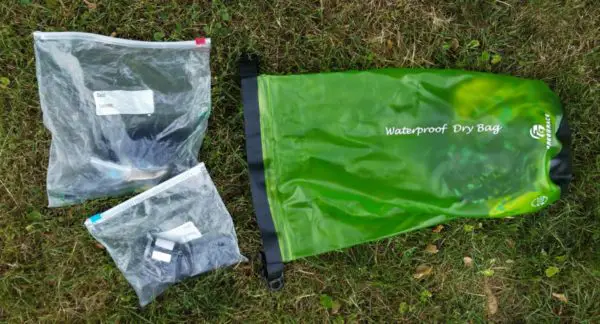
Now, with these category bags as compact as possible I will try and fit them into two larger main dry bags.
To keep each bag as small as possible I consider each item and how essential it is. I also consider the weight and size of each item.
My typical weight goal (minus water, food, paddle board and paddle) is to keep my camping gear under 35lbs which is not that hard.
One method to reduce the amount of gear you take is to spread all your gear out on the floor. Divide all this gear into two groups. Essential or Luxury. Now reduce those luxury items by 50%.
Portage: the carrying of boats or goods overland from one body of water to another or around an obstacle (such as a rapids)
No Dry Bags Needed Items
Bulky items that can handle getting wet should not take up room in a dry bag.
The tent, the hand pump, a closed-cell sleeping pad and an extra paddle do not have to be in a dry bag. Instead they are safely secured to the tail and nose of the paddle board. I take care to make sure they are secure.
I don’t worry about the tent getting wet as it often gets wet due to rain or dew. But I wrap it in a trash bag for protection.
I break the extra paddle down into sections then wrap them together with some big rubber bands. Then I secure them on the side of the nose. Out of the way. I make sure these are secured tight and hopefully will never have to be used for the duration of the trip.
All these items must be secured tight enough for a portage.
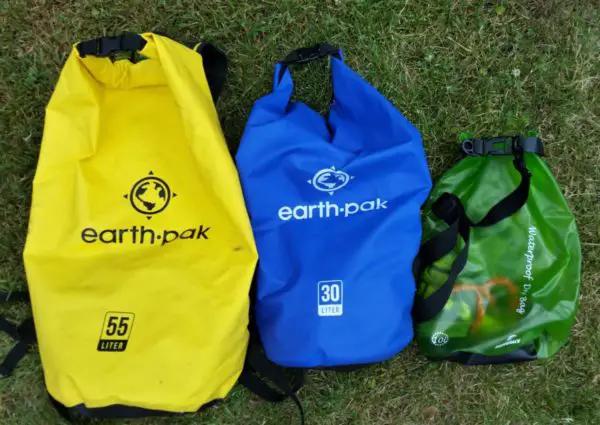
Inside the Main Dry Bag
How do I arrange the smaller bags inside the main bag? The bags I need during the day will go in last so they sit near the top of the main bag.
My sleeping system goes into the main bag first and will sit in the bottom of the bag all day. My food bag and kitchen bag will go inside last so I can quickly grab them for making lunch.
It’s critical that certain gear stays dry no matter what happens. So I use a trash bag to double-bag my sleeping bag and clothes. I will put my sleeping bag in it’s stuff sack, then inside a two thick trash bags. Then it goes into a main dry bag.
It’s best to assume
your gear
will go overboard
and to pack
likewise
Make sure to bring a “wet clothes” bag. If you put wet clothes in a bag with dry clothes they will all become wet.
I keep a separate set of dry “sleep only” clothes in my sleeping system dry bag. Sleeping in clean clothes makes for a better nights sleep. And they won’t carry any cooking odors into your tent that might attract animals.
How many bags do I typically take?
55L Main Dry Bag (one)
20L Main Dry Bag (one)
10L Dry Bags (three)
- Sleeping System
- GoPro Equipment
- Bug Out Bag
Garbage Bags (four)
- Clothing (2)
- Wet Clothing
- Tent
- Spare
Stuff Sacks (four)
- Kitchen
- Food
- Miscellaneous/Survival
- Fishing
How do I organize all these bags?
Main Bag #1 – 55L Dry Bag
A. Packed Clothing – Double Garbage Bags
- Wicking T-shirt
- Boardshorts
- Leggings
- Sun Hat
- Warm Hat
- Lightweight Balaclava
- Mosquito Headnet
- Lightweight Long Sleeve UPF Wicking Hoodie
- Lightweight Wicking Pants
- Fleece Top
- Long underwear (synthetic)
- Lightweight Quick Dry Towel
- Wicking Underwear
- Synthetic Socks
- Lightweight Trail Shoes
B. Sleeping System – 10L Dry Bag
- Sleeping Bag
- (Closed Cell Sleeping Pads Strapped on Deck)
- Inflatable Pillow
- Headlamp (extra batteries)
C. Kitchen Stuff Sack
- MSR PocketRocket
- Fuel Canister
- Lighters – 2
- Spork
- Cooking Pots -2
- Cup
- Water Bottles
- Sawyer Water Filter
D. Emergency/Miscellaneous Stuff Sack
- First Aid Kit
- Marine Flares
- Nylon Rope
- Space Blanket
- Duct Tape
- iSUP Repair Kit
- Extra Fin
Main Bag #2 – 20L Dry Bag
A. Food Stuff Sack
I keep the food bag here because I don’t want to keep the food near my clothes or sleeping bag in bear country. That may be extreme but it makes me feel better.
- Dehydrated Food Meals
- Tuna Packets
- Granola
- Tiny Plastic Bottle of Olive Oil
- Plenty Of Snacks
- Tea Bags
- Electrolytes
- Meds
B. GoPro Equipment Dry Bag 10L
- All my GoPro Equipment
- Batteries, Chargers, Etc.
C. Fishing Gear Stuff Sack
- Lures
- Pliers
- Line
Bag # 3 “Bug Out” – 10L
Easy Access – Often Used Items
- Sunglasses
- Plenty of Snacks
- Phone in Waterproof Case
- NOAA Weather Radio
- Compass
- Map
- Cash Money
- Knife
- Extra Top
- Snorkel Mask (maybe)
- Toilet Paper
- Plastic Trowel
- Sunscreen
- Insect Repellent
Strapped On Deck
- Tent
- Water Bottle
- Closed Cell Sleeping Pad
- Hand Pump
- Extra Paddle
- Fishing Rod and Reel
- Wet Clothes Bag
Where it it All Goes on the Deck
Important points
- The basic rule of gear placement is to keep the weight evenly balanced, side to side and front to back, on your sup deck.
- My heaviest gear bag (55L main dry bag) will be in the front bungee system but as close to my toes as practical.
- You want most of the weight near the center of the board – your toes and heels.
- A well packed paddle board will feel stable and paddle in a natural manner.
If I have two large main bags the smaller main bag will be secured behind.

I prefer to have most of the weight just in front of me near my feet. I find the board handles best with the weight up front.
The only time I will put heavier weight behind me is when I am paddling with a strong wind to my back. That weight will keep the nose up out of the water and the fin deep for better tracking.
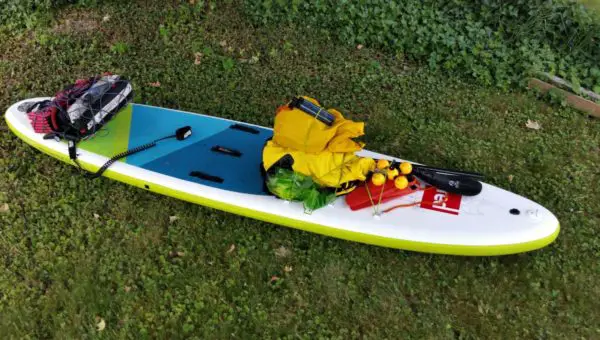
The “often used items” 10L dry bag will be on top or secured on the side of the large main bag. Within easy reach.
This “easy excess” bag contains snacks, a small knife, nylon rope, my weather radio, map & compass, some GoPro gear and possibly a hat or jacket. Anything I may need when paddling.
I also keep a water bottle secured near this bag. Again, for easy access.
A fanny/waist pack with a water bottle holder works well for some paddlers. But I prefer to keep my water bottle and small bag on the deck in front of me.
Heaviest items
near your
toes
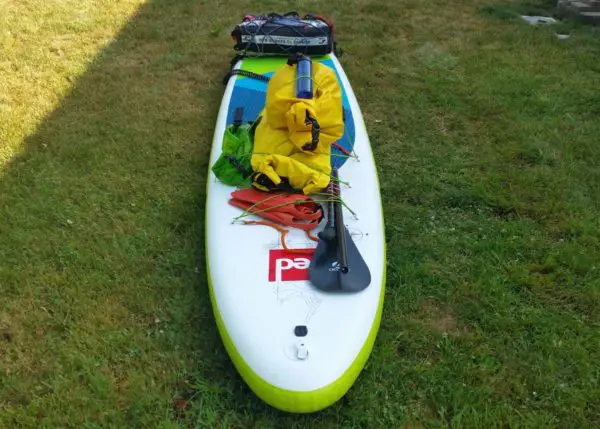
Sometimes I will secure a plastic gallon jug filled with water just behind me. It’s nice to have the extra water ready but remember a gallon of water weighs a bit over 8lbs.
The tent poles and stakes, hand pump and closed-cell sleeping pad are typically secured behind me on the tail.
The extra paddle will be secured on the side of the deck out of the way.
In general you pack most of the weight up front close to your feet. Light items can go farther out on the nose and tail.
It’s a good idea to test fit your gear on your paddle board. Even better, pack your gear on your paddle board and go for a paddle. Your board should feel stable and handle normally.
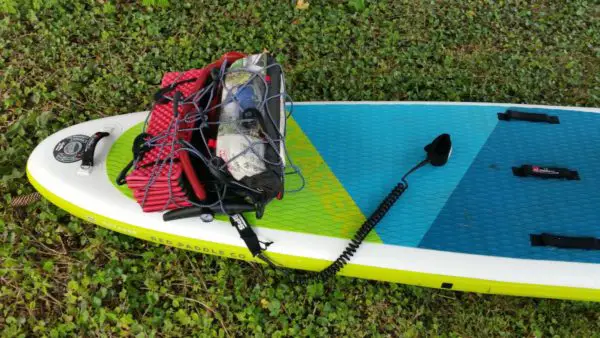
Test pack
your paddle board
and go for a paddle
to make sure
it feels
stable
If your board doesn’t feel stable you need to move things around until they do.
Yes, it will take a bit more effort to paddle because of the extra weight. But stability should not be affected. Even when turning or in rough water.
In summary
How you pack your gear on your paddle board comes down to personal preference. But it’s important that your gear is well organized for a smooth trip.
- You will want certain items at hand for easy access.
- Gear needs to be properly distributed on the deck so your paddle board is completely stable and paddles in a natural manner.
- The heaviest weight should be near your toes.
- Keep the weight near the center of the board.
Read: SUP Camping Tips
Read: Best Touring SUP for Camping
Read: How to Plan a Overnight SUP Camping Trip
Video: 3 Night Backcountry SUP Camping Trip
